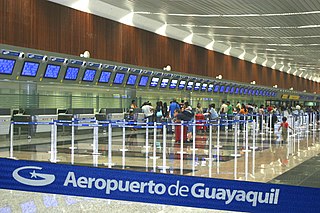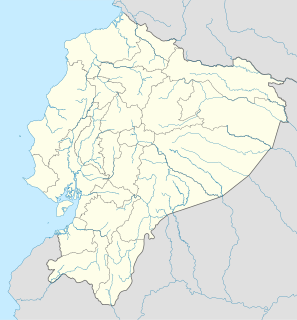| Tarapoa Airport | |||||||||||
|---|---|---|---|---|---|---|---|---|---|---|---|
| Summary | |||||||||||
| Airport type | Public | ||||||||||
| Operator | Government | ||||||||||
| Serves | Tarapoa, Ecuador | ||||||||||
| Elevation AMSL | 814 ft / 248 m | ||||||||||
| Coordinates | 00°07′22″S76°20′15″W / 0.12278°S 76.33750°W | ||||||||||
| Map | |||||||||||
| Runways | |||||||||||
| |||||||||||
Tarapoa Airport (Spanish : Aeropuerto Tarapoa) ( IATA : TPC, ICAO : SETR) is an airport serving Tarapoa, a town in the Sucumbíos Province of Ecuador.

Spanish or Castilian, is a Western Romance language that originated in the Castile region of Spain and today has hundreds of millions of native speakers in the Americas and Spain. It is a global language and the world's second-most spoken native language, after Mandarin Chinese.
An IATA airport code, also known as an IATA location identifier, IATA station code or simply a location identifier, is a three-letter code designating many airports around the world, defined by the International Air Transport Association (IATA). The characters prominently displayed on baggage tags attached at airport check-in desks are an example of a way these codes are used.

The ICAOairport code or location indicator is a four-letter code designating aerodromes around the world. These codes, as defined by the International Civil Aviation Organization and published in ICAO Document 7910: Location Indicators, are used by air traffic control and airline operations such as flight planning.
Contents
The runway length does not include 88 metres (289 ft) overruns at each end of the runway. The Tarapoa non-directional beacon (Ident: TRP) is located 0.5 nautical miles (0.93 km) off the approach threshold of Runway 30. [4]

A non-directional (radio) beacon (NDB) is a radio transmitter at a known location, used as an aviation or marine navigational aid. As the name implies, the signal transmitted does not include inherent directional information, in contrast to other navigational aids such as low frequency radio range, VHF omnidirectional range (VOR) and TACAN. NDB signals follow the curvature of the Earth, so they can be received at much greater distances at lower altitudes, a major advantage over VOR. However, NDB signals are also affected more by atmospheric conditions, mountainous terrain, coastal refraction and electrical storms, particularly at long range.













